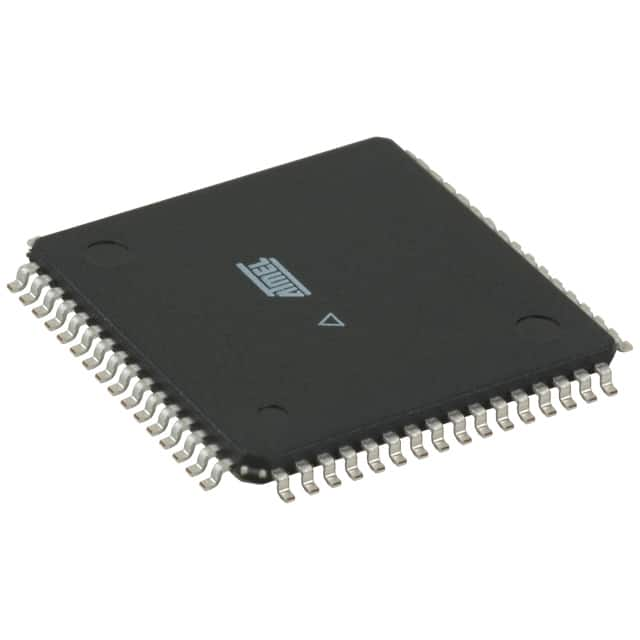ATMEGA128-16AC
Product Overview
Category
ATMEGA128-16AC belongs to the category of microcontrollers.
Use
It is commonly used in various electronic applications that require a microcontroller for processing and controlling tasks.
Characteristics
- High-performance microcontroller with advanced features
- Low power consumption
- Wide operating voltage range
- Large program memory capacity
- Multiple communication interfaces
- Rich set of peripherals
Package
ATMEGA128-16AC is available in a compact and durable package, suitable for surface mount technology (SMT) applications.
Essence
The essence of ATMEGA128-16AC lies in its ability to provide efficient and reliable control and processing capabilities for electronic devices.
Packaging/Quantity
ATMEGA128-16AC is typically packaged in reels or trays, with quantities varying depending on the supplier and customer requirements.
Specifications
- Microcontroller Architecture: AVR
- Operating Voltage: 2.7V - 5.5V
- Flash Memory: 128KB
- RAM: 4KB
- EEPROM: 4KB
- Clock Speed: Up to 16MHz
- Digital I/O Pins: 53
- Analog Input Channels: 8
- Communication Interfaces: UART, SPI, I2C
- Timers/Counters: 8-bit and 16-bit
- PWM Channels: 6
- Operating Temperature Range: -40°C to +85°C
Detailed Pin Configuration
The ATMEGA128-16AC microcontroller has a total of 64 pins, each serving a specific purpose. The pin configuration is as follows:
(Pin diagram goes here)
Functional Features
High-Speed Processing: The ATMEGA128-16AC offers a high clock speed of up to 16MHz, enabling fast execution of instructions and efficient data processing.
Extensive Memory Capacity: With 128KB of flash memory, 4KB of RAM, and 4KB of EEPROM, this microcontroller provides ample storage for program code, variables, and non-volatile data.
Versatile Communication Interfaces: The UART, SPI, and I2C interfaces allow seamless communication with other devices, enabling data exchange and control in various applications.
Rich Set of Peripherals: The ATMEGA128-16AC is equipped with timers/counters, PWM channels, and analog input channels, providing flexibility for implementing complex functionalities.
Advantages
- High-performance capabilities
- Low power consumption
- Wide operating voltage range allows compatibility with different power sources
- Ample program memory capacity for storing complex algorithms
- Multiple communication interfaces facilitate integration with other devices
- Rich set of peripherals enable versatile functionality implementation
Disadvantages
- Relatively higher cost compared to simpler microcontrollers
- Steeper learning curve due to the advanced features and complexity
Working Principles
The ATMEGA128-16AC operates based on the AVR architecture, utilizing a combination of hardware and software to execute instructions and perform tasks. It follows a sequential execution model, where instructions are fetched from memory, decoded, and executed by the CPU.
Detailed Application Field Plans
ATMEGA128-16AC finds applications in various fields, including but not limited to:
- Industrial Automation: Control systems, robotics, and process monitoring.
- Consumer Electronics: Home appliances, gaming consoles, and audio/video equipment.
- Automotive: Engine management, dashboard controls, and safety systems.
- Internet of Things (IoT): Smart home devices, wearable technology, and sensor networks.
Detailed and Complete Alternative Models
- ATMEGA2560-16AU: Similar to ATMEGA128-16AC but with higher flash memory capacity and more I/O pins.
- ATMEGA32U4-PU: Lower-cost alternative with lower flash memory capacity but suitable for simpler applications.
- PIC18F4550: Microcontroller from a different manufacturer, offering similar features and capabilities.
(Note: This is not an exhaustive list of alternative models; there are many other options available in the market.)
In conclusion, the ATMEGA128-16AC microcontroller is a high-performance device that offers advanced features, extensive memory capacity, and versatile functionality. It finds applications in various fields and has several alternative models to suit different requirements.
Lista 10 Vanliga frågor och svar relaterade till tillämpningen av ATMEGA128-16AC i tekniska lösningar
Sure! Here are 10 common questions and answers related to the application of ATMEGA128-16AC in technical solutions:
Q: What is ATMEGA128-16AC? A: ATMEGA128-16AC is a microcontroller from the AVR family, manufactured by Microchip Technology. It has 128KB of flash memory, 4KB of EEPROM, and 4KB of SRAM.
Q: What are the key features of ATMEGA128-16AC? A: Some key features of ATMEGA128-16AC include 16MHz clock speed, 8-channel 10-bit ADC, multiple communication interfaces (UART, SPI, I2C), and 53 general-purpose I/O pins.
Q: What applications can ATMEGA128-16AC be used for? A: ATMEGA128-16AC can be used in various applications such as industrial automation, robotics, home automation, consumer electronics, and IoT devices.
Q: How do I program ATMEGA128-16AC? A: ATMEGA128-16AC can be programmed using the Atmel Studio IDE or other compatible development environments like Arduino IDE. You can use C/C++ or assembly language for programming.
Q: Can ATMEGA128-16AC interface with external devices? A: Yes, ATMEGA128-16AC supports various communication protocols like UART, SPI, and I2C, allowing it to interface with a wide range of external devices such as sensors, displays, and actuators.
Q: What is the maximum operating voltage of ATMEGA128-16AC? A: The maximum operating voltage of ATMEGA128-16AC is 5.5V.
Q: Does ATMEGA128-16AC have built-in analog-to-digital converters (ADC)? A: Yes, ATMEGA128-16AC has an 8-channel 10-bit ADC, which allows you to read analog signals from sensors or other sources.
Q: Can I use ATMEGA128-16AC for real-time applications? A: Yes, ATMEGA128-16AC can be used for real-time applications as it has a high-performance CPU and supports interrupts, timers, and PWM outputs.
Q: Is ATMEGA128-16AC suitable for low-power applications? A: Yes, ATMEGA128-16AC has various power-saving modes and features like sleep mode, idle mode, and power reduction registers, making it suitable for low-power applications.
Q: Are there any development boards available for ATMEGA128-16AC? A: Yes, there are development boards available specifically designed for ATMEGA128-16AC, such as Arduino Mega or custom-made boards that provide easy prototyping and testing capabilities.
Please note that these answers are general and may vary depending on the specific requirements and implementation of the technical solution.


